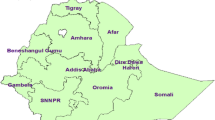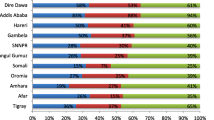Abstract
The World Health Organization in a bid to improve mother and child experience during pregnancy and delivery had recommended for optimal birth experience, at least four antenatal visits (ANC4+) in 2002 and recently an upward review to eight minimum antenatal visits (ANC8+) in 2016 to a health facility by pregnant women. This study therefore is to investigate the implications of these optimal recommendations with respect to spatial effects and determinants in Nigeria using data extracted from the 2018 Nigerian Demographic Health Survey. Bayesian models with appropriate priors were fitted for each of these distributions using structured additive regression modeling technique. The Integrated Nested Laplace Approximation method was used to estimate the parameters of the models. A north–south dichotomy in the spatial distribution of ANC utilization in Nigeria was prominent only at the ANC8+ utilization level. Furthermore, some interesting revelations showed that Igbo and Yoruba women in southern Nigeria shared association with attaining four antenatal visits during pregnancy, while only Igbo women had high potential for eight antenatal visits. Only Adamawa state was significantly highly associated with the two optimal ANC levels (ANC4+ and ANC8+) in the Northern region. The nonlinear effects of respondents’ current age at birth at the time of survey showed the older women have higher potential to attain higher utilization levels than the younger ones.


Similar content being viewed by others
References
Adewuyi, E. O., Auta, A., Khanal, V., Bamidele, O. D., Akuoko, C. P., Adefemi, K., & Zhao, K. L. (2018). Prevalence and factors associated with underutilization of antenatal care services in Nigeria: A comparative study of rural and urban residences based on the 2013 Nigeria demographic and health survey. PLoS ONE, 13(5), 0197324. https://doi.org/10.1371/journal.pone.0197324
Akowuah, J. A., & Danquah, B. A. (2019). Determinants of women’s perceived satisfaction on Antenatal care in urban Ghana: A cross-sectional study. Clinical Journal of Obstetrics and Gynecology, 2, 038–053. https://doi.org/10.29328/journal.cjog.1001022)
Ayanmolowo, L. B., Odetola, D. T., & Ayanmolowo, S. J. (2020). Determinants of choice of birth place among women in rural communities of Southwestern Nigeria. International Journal of Africa Nursing Sciences, 13, 100244.
Ayoola, A. B. (2011). Reducing the number of antenatal care visits in low-risk pregnancies increases perinatal mortality in low- and middle-income countries; Women in all settings prefer the standard visit schedule. Evidence-Based Nursing, 14(2), 55–56.
Babalola, S., & Fatusi, A. (2009). Determinants of use of maternal health services in Nigeria—Looking beyond individual and household factors. BMC Pregnancy and Childbirth, 9, 43.
Besag, J., York, Y., & Mollie, A. (1991). Bayesian image restoration with two applications in spatial statistics (with discussion). Annals of the Institute of Statistical Mathematics, 43, 1–59.
Dahiru, T., & Oche, O. M. (2015). Determinants of antenatal care, institutional delivery and postnatal care services utilisation in Nigeria. Pan African Medical Journal, 22, 1–17.
Dowswell, T., Carroli, G., Duley, L., Gates, S., Gulmezoglu, A. M., Khan-Neelofur, D., & Piaggio, G. G. P. (2010). Alternative versus standard packages of antenatal care for low-risk pregnancy. Cochrane Database of Systematic Reviews, 1, 000934.
Fahrmeir, L., Kneib, T., Lang, S., & Marx, B. (2013). Regression: Methods, methods and application. Springer.
Fotso, J. C., Ezeh, A. C., & Essendi, H. (2009). Maternal health in resource poor urban settings: How does women’s autonomy influence the utilisation of obstetric care services? Reproductive Health, 6, 9.
Gayawan, E. (2014). A Poisson regression model to examine spatial patterns in antenatal care utilization in Nigeria. Population, Space and Place, 20(6), 485–497. https://doi.org/10.1002/psp.1775
Gayawan, E., & Omolofe, O. T. (2016). Analyzing spatial distribution of antenatal care utilization in West Africa using a geo-additive zero-inflated count model. Spatial Demography, 4(3), 245–262. https://doi.org/10.1007/s40980-016-0027-3
Http. (2020) https://extranet.who.int/rhl/topics/improving-health-system-performance/who-recommendation-antenatal-care-contact-schedules. Accessed May 2020.
Isiugo-Abanihe, U. C. (1995). Bridewealth, marriage and fertility in the East Central states of Nigeria. Genus, 51(3–4), 151–178.
Kabir, M. R., & Islam, H. (2019). Optimum utilization of antenatal care (ANC 4) service is still a long way down the road in Bangladesh: Analysis of Bangladesh demographic health survey data. Food and Public Health, 9(1), 21–31. https://doi.org/10.5923/j.fph.20190901.04
Lincetto, O., Mothebesoane-Anoh, S., Gomez, P., Munjanja, S., & Munjanja, S. (2006). Chapter 2: Antenatal care. In J. Lawn & K. Kerber (Eds.), Opportunities for Africa’s Newborns: Practical data, policy and programmatic support for newborn care in Africa (pp. 51–62). World Health Organization.
Lindgren, F., & Rue, H. (2015). Bayesian spatial modelling with R-INLA. Journal of Statistical Software, 63(19), 1–25.
Ntambue, A. M., Malonga, F. K., Dramaix-Wilmet, M., Ngatu, R. N., & Donnen, P. (2016). Better than nothing? Maternal, newborn, and child health services and perinatal mortality, Lubumbashi, democratic republic of the Congo: A cohort study. BMC Pregnancy and Childbirth, 16, 89.
Nwatu, S. I., & Nwogugu, E. I. (2018). Constitutionality of ‘bride price’ in Nigeria: Echoes from the supreme court of Uganda. Commonwealth Law Bulletin, 44(2), 182–204. https://doi.org/10.1080/03050718.2019.1605917
Oladapo, O. T., & Osiberu, M. O. (2009). Do sociodemographic characteristics of pregnant women determine their perception of antenatal care quality? Maternal and Child Health Journal, 13, 505–511.
Pallikadavath, S., Foss, M., & Stones, R. W. (2004). Antenatal care: Provision and inequality in rural north India. Social Science & Medicine, 59, 1147–1158.
Shahabuddin, A. S. M., et al. (2015). Adolescents’ use of maternal health services. Tropical Medicine and International Health, 20(7), 822.
Spiegelhalter, D. J., Best, N. G., Carlin, B. P., & Van der Linde, A. (2002). Bayesian measures of model complexity and fit (with discussion). Journal of the Royal Statistiscal Society B, 64, 583–640.
Srivastavaa, S., Chaurasiab, H., Singhc, K. J. K., & Chaudhary, P. (2020). Exploring the spatial patterns of cesarean section delivery in India: Evidence from National Family Health Survey-4. Clinical Epidemiology and Global Health, 8, 414–422. https://doi.org/10.1016/j.cegh.2019.09.012)
Tessema, Z. T., & Animut, Y. (2020). Spatial distribution and determinants of an optimal ANC visit among pregnant women in Ethiopia: Further analysis of 2016 Ethiopia demographic health survey. BMC Pregnancy and Childbirth, 20, 137. https://doi.org/10.1186/s12884-020-2795-4
United Nations. (2014). Framework of actions for the follow-up to the programme of action of the international conference on population and development beyond 2014. United Nations.
USAID. (2015). Ending preventable maternal mortality: USAID maternal health vision for action evidence for strategic approaches. USAID.
WHO. (2016). WHO recommendations on antenatal care for a positive pregnancy experience. WHO.
WHO Africa. (2019). HIV initiative ‘prevention of mother-to-child transmission’ saves exposed infants in Nigeria. WHO Africa.
WHO, UNICEF, & The World Bank. (2012). Trends in maternal mortality: 1990 to 2010. World Health Organization.
World Health Organization and UNICEF. (2003). Antenatal care in developing countries: Promises, achievements and missed opportunities: An analysis of trends, levels and differentials (pp. 1990–2001). WHO and UNICEF.
Author information
Authors and Affiliations
Corresponding author
Ethics declarations
Conflict of interest
On behalf of all authors, the corresponding author states that there is no conflict of interest.
Additional information
Publisher's Note
Springer Nature remains neutral with regard to jurisdictional claims in published maps and institutional affiliations.
Rights and permissions
About this article
Cite this article
Olopha, P., Aladeniyi, O. & Oladuti, O. Investigating Spatial Patterns and Determinants of Optimal Antenatal Care Attendance Among Pregnant Women in Nigeria. Spat Demogr 10, 311–328 (2022). https://doi.org/10.1007/s40980-021-00083-w
Accepted:
Published:
Issue Date:
DOI: https://doi.org/10.1007/s40980-021-00083-w




